2022-23 Global Sales Force Report
The 2025 Sales Enablement Playbook for Field Leaders
The Evolving role of sales enablement
Sales enablement has transitioned from being a tactical support function to a core driver of revenue growth, particularly for distributed sales teams. As highlighted in PwC’s Consumer Intelligence Series report, 73% of customers consider experience a key driver of brand loyalty, reinforcing the need for sales teams to deliver consistent, high-quality interactions. Effective sales enablement now focuses on shaping behaviors, fostering cross-departmental collaboration, and ensuring measurable outcomes. For remote sales teams, particularly in field sales enablement, structured practices are critical to maintaining consistency and performance.
After working with over 200 organizations with large sales forces, we’ve seen sales enablement leaders succeed by implementing the strategies outlined in this playbook, developed through our analysis of billions of data points to identify the activities that drive the most sales success. Today, we are sharing this playbook, which has been instrumental behind numerous business success stories.
Now, let’s dive into the key “Plays” for transforming your sales enablement strategy in 2025.
Cultivating a sales team that thrives
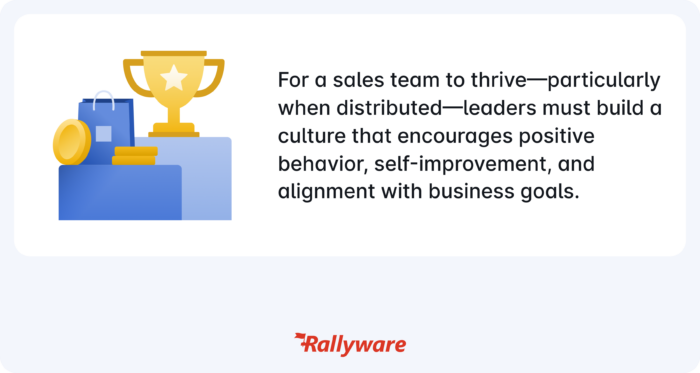
Play 1: Build a collective identity
In a remote environment, it is crucial to foster a sense of community and alignment. To do this:
- Organize frequent virtual success-sharing sessions where team members celebrate wins, discuss challenges, and align their goals with the company’s mission. These should highlight the broader company vision and how individual efforts contribute.
- Implement peer recognition initiatives to foster a sense of camaraderie. These could be in the form of digital badges or public recognition.
- Use community-based tools and communication channels to create a space where sellers can exchange tips and support each other, fostering a stronger collective identity.
Play 2: Sales enablement through habit building
Long-term success in sales is the result of small, consistent actions. Encourage sellers to:
- Break down their daily tasks into habit-forming activities, such as scheduling a specific number of follow-ups or making sure they learn one new fact about a prospect every day.
- Automate habit reminders at strategic times, such as prompting sellers to follow up with untouched leads or reminding them to personalize their outreach based on customer data.
- Create simple, gamified habit challenges that encourage sellers to complete daily tasks, like sending a certain number of personalized emails.
Creating a flywheel of success
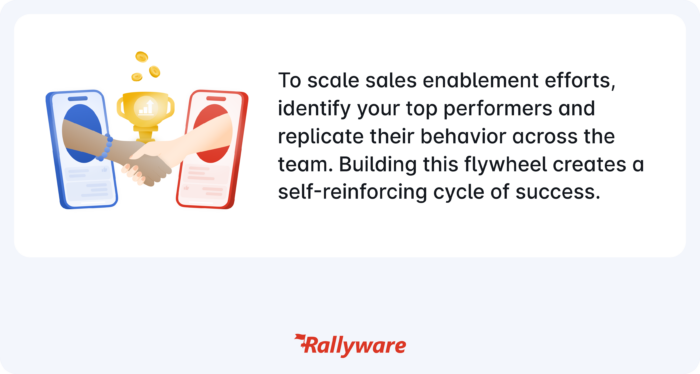
Play 3: Find your sales champions
Top performers should not only be celebrated but also be utilized to lift the entire team:
- Identify your top sellers using both performance metrics and qualitative feedback, focusing on those who demonstrate not only high output but also consistency in client relationships.
- Create a peer-to-peer coaching program where top performers mentor others, sharing strategies, tools, and techniques.
- Incentivize mentoring by rewarding top sellers for leading knowledge-sharing sessions, creating a learning culture where everyone benefits from each other’s strengths.
- Know what motivates top sellers—often, public recognition is their top driver.
Play 4: Feedback that sticks
Feedback needs to be timely, relevant, and focused on actionable improvements:
- Implement a “Quick feedback Friday” program, where sellers receive real-time feedback on their week’s activities. Use these sessions to address both successes and areas for improvement.
- Use digital dashboards that allow sellers to track their own performance in real-time. This gives them autonomy over their progress and empowers them to make immediate adjustments.
- Combine feedback with behavioral data to focus on how sellers engage with customers, allowing them to refine their approach and close more deals.
Sales enablement goes behavioral
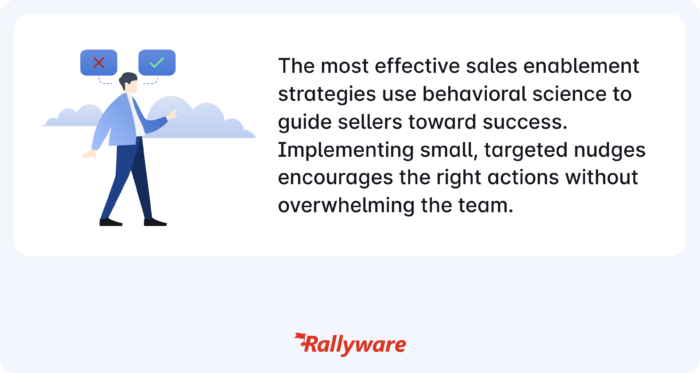
Play 5: Nudge-based selling
Nudges help sellers stay on track by reminding them to take action when it matters most. Here’s how to incorporate nudges effectively:
- Use automated nudges to remind sellers about key activities such as following up with prospects or revisiting inactive leads. These nudges should be context-specific to ensure maximum relevance.
- Implement nudges that trigger based on recent activity. For example, a nudge can be sent when a seller logs a new contact, prompting them to set a follow-up reminder for that lead.
- Highlight small wins regularly—such as advancing a deal or securing a referral—through notifications or internal communications to build confidence and motivation.
Play 6: Less overthinking, more selling, with a human touch
Automating repetitive tasks empowers sellers to focus on high-impact activities, while emphasizing the human touch that distinguishes in-person sales from e-commerce:
- Implement CRM-driven automations that prioritize tasks based on prospect stage and urgency, freeing sellers to concentrate on valuable leads at the right time.
- Use automated sales scripts that can be quickly customized, ensuring personalized interactions that enhance human connection during conversations.
- Automate lead behavior tracking and next-action suggestions to reduce administrative burdens, while allowing sellers to invest more time in meaningful, relationship-driven interactions.
Boosting performance with a smarter sales force
In 2025, sales teams expect data-driven, performance-focused learning that is highly personalized and immediately applicable. Continuous training and micro-learning are critical to ensuring that knowledge is retained and applied efficiently.
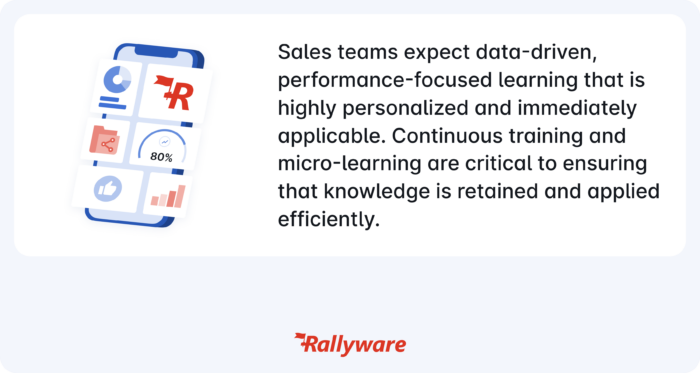
Play 7: Cognitive ease in sales tools
Sales tools should minimize the mental load and integrate smoothly into sellers’ workflows:
- Choose intuitive, mobile-accessible tools for on-the-go learning and resource access.
- Offer real-time prompts to review customer data before calls, enhancing seller performance by making relevant information available when needed.
- Link performance data with learning modules to provide personalized training based on real-time sales interactions, ensuring that every learning opportunity is targeted and impactful.
Play 8: Daily 5-minute learning bursts
Micro-learning fits perfectly into the busy schedules of modern sellers:
- Break learning content into 5-minute segments that address specific, real-world situations sellers face daily without taking away much of productive seller time.
- Encourage daily learning with meaningful rewards or recognition for completing modules, reinforcing immediate application to current challenges.
- Integrate learning platforms with your CRM to deliver timely learning nudges after key customer interactions, enabling sellers to immediately apply insights to their ongoing sales efforts.
Empowering field autonomy
Field enablement leaders can empower sellers by fostering self-reliance through frameworks for setting personal goals and tracking real-time performance. This approach encourages accountability, driving motivation and autonomy, as sellers take ownership of their success.
Play 9: Architect systems for self-driven success
Design systems that empower sellers to manage their success independently:
- Promote a culture of initiative and autonomy, encouraging sellers to take charge of their development by showing them the impact of their learning on their progress.
- Build self-service platforms for accessing training, resources, and feedback on-demand when needed.
Measuring what matters
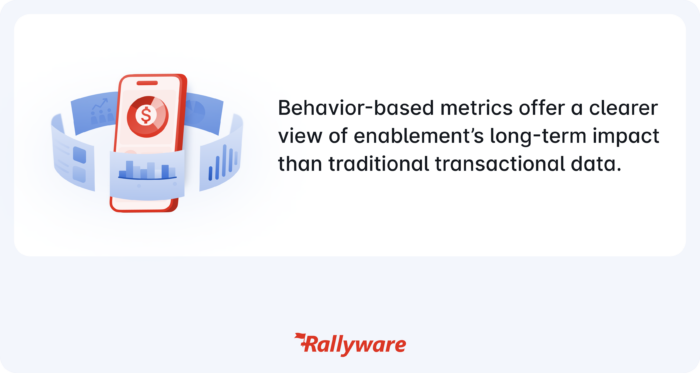
Play 10: Create micro-goals for continuous wins
Large goals can feel overwhelming. Breaking them into smaller, actionable steps helps sellers stay motivated and focused:
- Break down larger objectives into micro-goals like scheduling a follow-up meeting or advancing a lead to the next stage. This provides regular opportunities for wins and boosts seller morale.
- Celebrate small achievements to build momentum and encourage sellers to keep moving toward larger targets. This can be done through peer recognition, badges, or internal communications celebrating progress.
Play 11: Focus on behavior change
Instead of solely tracking the number of transactions per seller, focus on how seller behavior evolves over time:
- Track best practice adoption, such as how frequently sellers engage with training materials or apply learned techniques in real-world scenarios. This provides a clearer picture of long-term enablement success.
- Use metrics like follow-up frequency or client engagement scores to evaluate the strength of customer relationships, which are critical for closing deals and ensuring repeat business.
- Incorporate customer feedback loops to understand how sellers’ interactions are perceived and where they can improve, driving better relationship-building.
- Connect behavioral metrics to revenue goals to demonstrate the direct impact of enablement efforts on business success.
Scaling sales enablement
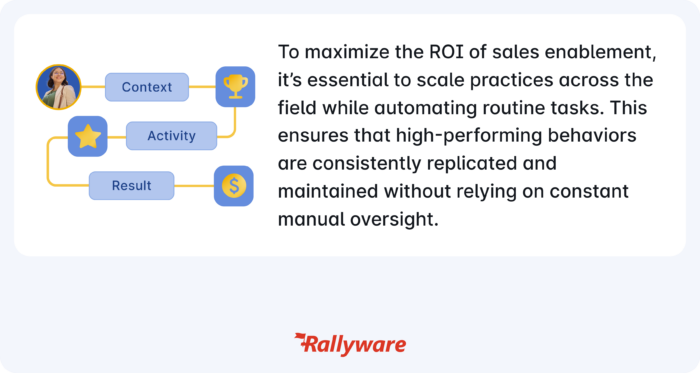
Play 12: Standardizing success across teams
To scale success, sales enablement leaders should standardize the behaviors that have been proven to drive the best outcomes:
- Use data analytics to identify top-performing behaviors and codify them into a sales playbook, ensuring consistent execution across all teams.
- Train all teams on the playbook, but allow for local adaptations to address regional specifics, providing autonomy where necessary while maintaining core behaviors.
- Regularly update the playbook using feedback and sales data, ensuring that it evolves with market changes and remains relevant to different regions and products.
Play 13: Automating enablement for high-impact execution
Automation can drastically improve the efficiency of sales teams by freeing up time and resources that would otherwise be spent on routine tasks:
- Automate routine tasks like content delivery, lead prioritization, and performance tracking, ensuring that sellers are always equipped with the latest insights and can focus more on high-value activities like relationship-building and closing deals.
- Implement AI-powered sales enablement tools that provide sellers with real-time recommendations for their next-best actions, helping them stay on track and prioritize effectively.
- Automate coaching and training delivery, sending personalized learning modules or performance insights to sellers based on their needs and progress.
Mastering sales enablement for 2025 and beyond
Sales enablement is no longer just about providing tools and training; it’s about fostering behavioral change, building scalable systems, and leveraging automation for consistent, high-impact performance. After working with over 200 organizations with large sales forces, we’ve seen sales enablement leaders succeed by following the strategies in this playbook. These strategies, which we are now sharing with the broader public, have helped create teams that achieve not only short-term wins but also sustained, long-term revenue growth.
Ready to transform your sales team? Contact us to learn more about how Rallyware can help your organization enhance its sales enablement strategy, implement it at scale, and drive revenue growth in 2025 and beyond.
News and Insights on Workforce Training & Engagement
We’re among top-notch eLearning and business engagement platforms recognized for effective training and talent development, helping to empower distributed workforces
Subscribe
